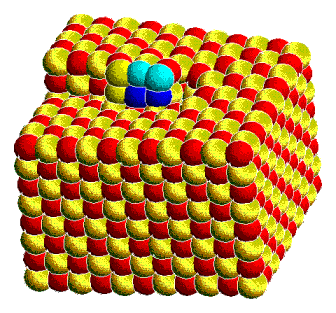


This page reflects the status of the HPCC in 1998
The two academic staff associated with the High Performance Computing Centre are:
Currently, there are eight postgraduate students in the group and support from the EPSRC for two postdoctoral fellows.
The research activities of the HPCC fall into three main areas: parallel computer systems, high performance computing applications and software technology for HPC.
We are always looking for new bright and well-motivated research students to join in our wide range of activities. Many of our group were initially trained in the physical sciences; intellect and motivation are far more important to us than any specialisms in electronics or computing.
Our current slideshow of research activities, mainly by our postgraduate students, can be found here.
We led the development of two generations of parallel computer, built around the T800 and T9000 transputers, which have been marketed worldwide by companies in the UK and France. Currently, we use three substantial parallel computer systems on the Southampton campus: a CRAY Origin, an IBM SP2 and a Meiko CS2 in addition to our own cluster of eight 1Gflop DEC Alpha systems. We also make extensive use of the Cray T3D national facility at Edinburgh, for which we are one of the three national support centres; we led the benchmarking activity on behalf of the EPSRC to select the Cray's replacement. These systems provide the core for our wide range of collaborations in Grand Challenge computations.
An exciting new technology that we are investigating is commodity supercomputing. We have recently acquired an 8-processor DEC Alpha cluster with 2Gbyte total RAM connected by 100MBit switched Ethernet. We are developing this as a highly, cost-effective HPC facility running Windows NT. Further details of this work are available on our Beowolf NT web page.
Our research work in applications of HPC is almost all collaborative; we bring our expertise in efficient computational techniques and data handling to bear on a wide range of problems in several disciplines. We believe that these wide collaborations are our first key strength; they also guarantee a broad range of challenging future career options for our young researchers.

View of crystal growth at a screw dislocation in magnesium oxide
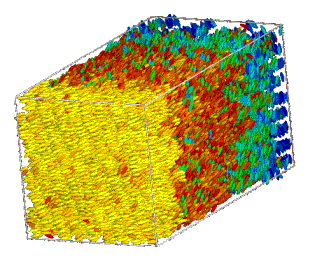
A simulation of a liquid crystal twisted grain boundary
We are working with a team led by Professor Catlow at the Royal
Institution to develop programs for the Cray T3D to provide detailed simulations
of crystal growth at dislocations. We are also developing molecular dynamics
simulations to provide detailed models of liquid crystal grain boundaries with
Dr Allen at the University of Bristol.
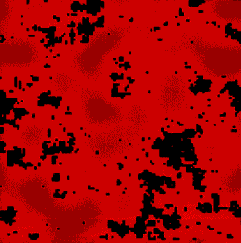
Simulation of an oil reservoir The shading indicates fluid pressure;
black elements represent failed parts of the fault
In collaboration with the British Geological Survey and the University of
Durham, we have developed programs to model the interaction between rock
fractures and fluids. This echnology should substantially enhance the ability to
exploit oil reservoirs.
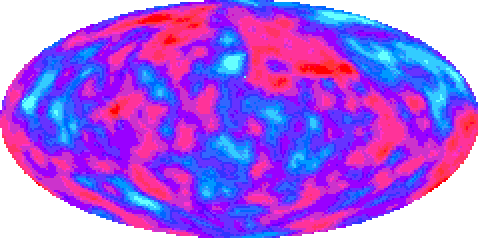
A simulation of the fluctuations in the cosmic microwave background
Cosmic strings offer an exciting, if speculative link between the
distribution of clusters of galaxies and the spatial fluctuations in the cosmic
microwave background radiation. The computer simulation of these fast-moving
interacting strings on parallel computers is, however, a challenging problem
which we have worked on with teams at Cambridge and Sussex Universities.
For some lotteries the organisers reveal statistical information about
players' choices of numbers and combinations of numbers. Such information is of
considerable interest in modelling the behaviour of lottery players, and can
enable players to increase their expected winnings by choosing unpopular
combinations of numbers. For the UK National Lottery, however, only the number
of prize winners in each prize category and the total number of players is
released for each draw. Working with our Physics Department, we have used the
Maximum Entropy method to estimate the probability of each of the 14 million
tickets being chosen by players in the UK National Lottery. By choosing
unpopular combinations of numbers, one's expected winnings can be doubled.
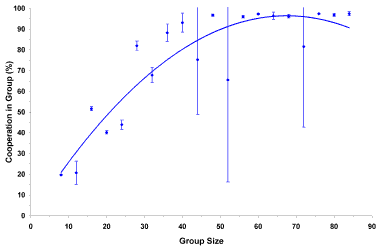
Growth of sustained cooperation with group size
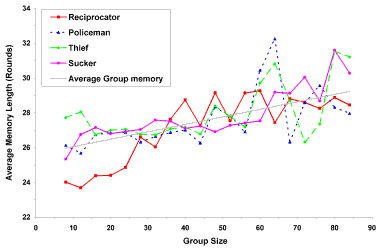
Growth of average memory with group size
Working with our Archaeology Department, we are developing a new class of
models for the study of cooperation in groups, based on the repeated Prisoner's
Dilemma Game. This study focuses on the manner in which group size, and the
sophistication of individual strategies, affects the ability of a group to
sustain global cooperative behaviour. Simulations so far have yielded results
exhibiting a number of features reminiscent of group behaviour. In particular,
we find that as group size is increased, cooperation can be sustained and
individuals with longer memories are favoured. This model seems to give
theoretical support to field observations of a positive correlation between
group size and neocortex size in primates.
Collaborating with our Mathematics Department, and the National Academy of Sciences in the Ukraine, we are performing calculations of the light scattering properties of Polymer Dispersed Liquid Crystal films in the long wavelength régime, where the Rayleigh-Gans approximation applies. PDLC films combine some useful properties of ceramic and liquid crystalline materials. There are a number of current and potential applications for these devices, ranging from large flexible windows and signs, to high resolution active matrix addressing devices, and direct view displays.
High temperature superconductors were only discovered in 1987, and at present no satisfactory theory exists to explain their behaviour. By performing computational simulations it may be possible to develop insight into the theoretical basis for high temperature superconducting behaviour. Both high temperature superconductors and conventional superconductors contain vortices; a term used to describe the circulating supercurrents in the material. It is the pinning mechanism of these vortices which is believed to allow the superconductors to carry high currents. Our simulations are more concerned with increasing the current carrying capability of superconductors, than their critical temperature.
Previous work at Southampton has focused on two dimensional Monte Carlo simulations of high temperature superconductors using the Metropolis-Hastings algorithm. We are currently working on a parallel code, which will enable us to simulate three dimensional layered superconductors.
Although several of our group concentrate on applications in the physical sciences, we also maintain a strong interest in the development of advanced software systems to support parallel programming. We believe that this mix of sophisticated computer science alongside real applications development, forms our second key strength.
This EPSRC-funded project is developing ways of using symbolic model checking, already widely used to validate hardware designs, to validate computer software. We are devising methods of generating large but useful finite state models from the text of parallel computer programs which are then analysed by tools such as SMV and FDR. This work is in collaboration with IBM, Formal Systems (Europe) Ltd and SGS-Thomson Microelectronics.
The Java programming language is now very fashionable for world-wide-web applications. We have been using Java and its security features to allow users to insert their own Java code into the kernel of a multitasking UNIX operating system. Our kernel Java technology permits ordinary users to gain substantial efficiency advantages by avoiding the overheads of crossing protection domains between input-output devices and their user code. This EPSRC-funded project is in collaboration with Parsys Ltd.
Occam is a parallel programming language especially well suited to the development of small embedded systems. Our compiler, implemented using advanced vector dependency analysis technology, is now widely used; it was featured in Dr Dobbs Journal in mid 1997.
D.A.Nicole, K.Takeda and I.C.Wolton, ' HPC on DEC Alphas and Windows NT', Proc, HPCI '98 Conf., Manchester 1998, 551-557.
K.Takeda, O.R.Tutty and A.D.Fitt, ' A Comparison of four viscous models for the discrete vortex method', Proc. 13th AIAA Computational Fluid Dynamics Conference, Snowmass, Co., 1997, Paper no. 97-1977.
M.Manjunathaiah and D.A.Nicole, ' Precise analysis of array usage in scientific programs', Scientific Programming, 6, 1997, 229-42.
V.Yu.Reshetnyak, T.J Sluckin and S.J.Cox, ' Effective Medium Theory of Polymer Dispersed Liquid Crystal Droplet Systems I: Spherical Droplets', J.Phys, D: Appl. Phys 29(9), 1996, 2459-2465.
V.Yu.Reshetnyak, T.J Sluckin and S.J.Cox, ' Effective Medium Theory of Polymer Dispersed Liquid Crystal Droplet Systems II: Partially oriented bipolar droplets', J.Phys, D: Appl. Phys 30, 1997, 3253-3266.
S.J.Cox, G.J.Daniell and D.A.Nicole, ' Maximum Entropy, Parallel Computations and Lotteries', Proceedings of the International Conference on Parallel and Distributed Processing Techniques and Applications 1998 (PDPTA 1998), 1252-58.
S.J.Cox, V.Yu.Reshetnyak and T.J.Sluckin, ' Theory of Dielectric and Optical Properties of PDLC films', Molecular Crystals and Liquid Crystals 320, 1998, 301-319.
S.J.Cox, G.J.Daniell and D.A.Nicole, ' Using Maximum Entropy to Double One's Expected Winnings in the UK National Lottery 1998', J.R.Statist.Soc.D 47, 1998, 629-641.
S.J.Cox, D.A.Nicole and K.Takeda, ' Commodity High Performance Computing at Commodity Prices', WOTUG-21 Proc, 21st World Ocean and Transputer User Group Technical Meeting, Canterbury, 1998.
M.A.Osipov, T.J.Sluckin and S.J.Cox, ' Influence of permanent molecular dipoles on surface anchoring of nematic liquid crystals', Phys.Rev, E, 55 (1, Pt A), 1997, 464-76.
S.J.Cox, V.Yu.Reshetnyak and T.J.Sluckin, ' Effective Medium Theory of Light Scattering in PDLC films', J.Phys. D: Appl Phys 31, 1998, 1611-25.
K.Takeda, I.C.Wolton and D.A.Nicole, ' Software Probability and Maintenance', Proc. HPCI '98 Conf., Manchester 1998, 119-125.
D.A.Nicole, K.Takeda, I.C.Wolton and S.J.Cox, ' Southampton High Performance Computing Centre', Proc. HPCI '98 Conf., Manchester, 1998, 33-41.
Allsopp, N.K., Canizares, J.S., Raimondi, R.and Lambert, C.J. Giant conductance oscillations in mesoscopic Andreev interferometers. Journal of Physics-Condensed Matter, 8(26), 1996, L377-84.
Nicole, D.A. and Sivaram, R. SCOTT: The Southampton COFF tools for transputers. WOTUG-19, Proceedings of the 19th World occam and Transputer User Group Technical Meeting, 1996, 191-206.
Volkov, A., Allsopp, N. and Lambert, C.J. Crossover from mesoscopic to classical proximity effects, induced by particle-hole symmetry-breaking in Andreev interferometers. Journal of Physics-Condensed Matter, 8(4), 1996, L45-50.
HPC on WindowsNT clusters: [Microsoft]
HPVM on Alphas under WindowsNT: [NPACI, San Diego]
Atmosphere Modelling: [UK Atmosphere Modelling Consortium, University of Reading]
Direct Numerical Simulation of Fluid Flow: [Queen Mary & Westfield College]
Global Ocean Circulation: [University of Southampton, NERC]
Group Behaviour Simulations: [Southampton Archaeology]
Liquid Crystals: [Southampton Maths]
Materials Chemistry: [Royal Institution]
Maximum Entropy Analysis of Lottery Results: [Southampton Physics]
Southampton Portable occam Compiler: [IBM, INMOS, Meiko, Parsys, Autronica]
Structure in DNA: [Southampton Chemistry]
3D Simulation of high Tc Superconductor: [Southampton Physics]
23 nodes RS6000 model 390 "Power 2"
128/256 Mbytes DRAM
2 x 2Gbyte hard disk
4 nodes have ATM interface
100Gbytes SSA disk
8 vector nodes
66MHz Super Sparc
2 x Fujitsu micro vector processor
128 Mbytes DRAM
2 Gbyte disk
6 MIPS 8000 processors
384 Mbytes shared DRAM
6 Gbyte shared disk
Housed in the Computational Engineering and Design Centre
Eight nodes each with
- 500MHz Alpha 21164 processor
- 256 Mbyte RAM
- 2.5 Gbyte EIDE drive
- Two additional 5Gbyte drives to support Windows NT 5.0 and Linux tests
- Windows NT version 4
Server node
- 200MHz Pentium
- 32Mbyte RAM
- 4 x 5 Gbyte IDE drive
- 30 Gbyte DLT backup
- Debian Linux
Network connectivity
- 100M bit Ethernet
- 100M bit twelve port Ethernet switch
See our separate page on MPI on DEC Alphas running Windows NT
We are always keen to attract new postgraduates with a first or strong upper second class degree in Engineering, Computer Science, a Physical Science or Mathematics. UK candidates can usually be EPSRC supported; foreign candidates will usually need to be supported from their home countries.
We also have occasional vacancies for postdoctoral researches in the group; please see our web pages for the current situation.
As you will have read, our internal and external collaborations are vital to the success of the HPCC. Researchers at other Universities and in Industry with interesting computational problems are invited to contact Dr Denis Nicole to discuss possible new collaborations.
The group's web pages may be found at
Informal inquiries can be addressed to Dr Denis Nicole by Email to
or by telephone to
+44 1703 592703.
For the Department's application forms and general information, you should contact
Postgraduate Admissions
Department of Electronics and Computer
Science
University of Southampton
Southampton SO17 1BJ
United
Kingdom
Phone: +44 1703 592882
Fax: +44 1705 594498
Last updated 15th October 1998. Maintained by Denis A Nicole.